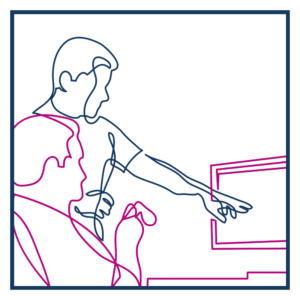Nowadays, it’s not unusual for organisations to employ five generations. People are retiring later and later and we are now seeing Gen Z to baby boomers in the same workplace. Organisations can use multi-generational working to their advantage as it brings huge opportunities, such as improved innovation. In this article, we look at why organisations should embrace the challenge as well as the change.
Broader context on new ideas from a bigger ‘memory bank’
Between them, five generations in the workplace have access to a huge amount of knowledge and information from the present day back through many years. Organisations can tap into this ‘memory bank’ to more accurately contextualise the world around them.
As we’ve discussed in the past, a lack of context encourages poor decision-making: if you don’t know why something didn’t work in the past, you may think it’ll work in the future. All ideas need to be given historical, economic and social context to be accurately judged.
And it’s not only new ideas: it’s also external change agents, such as market movements. Knowledge and wisdom from the multi-generational ‘memory bank’ makes it less likely organisations will overreact or underreact to these developments.
This knowledge tends to be tacit knowledge, which is hard to codify and pass onto others. Organisations must therefore develop strong processes for tapping into the collective knowledge of their workforce to ensure valuable insight is not missed.
More targeted – and tested – messaging
Whether your organisation targets its products towards one age range or many, your marketing strategy can benefit from the insights of a multi-generational workforce. This can help the development – and testing – of for example, marketing material.
Essentially, you can gather insight for each generation in the workplace on what appeals to them, messages that put them off, and how they make their purchasing decisions etc. this will inform the design of your marketing collateral.
When it comes to testing, target someone who didn’t help you develop the material. Once the results are in, you can tweak your designs as necessary to make them more appealing. By using your workforce in this way you can shortcut market testing and help ensure market fit.
Better mentoring programmes – and access to reverse-mentoring
Mentoring has many benefits to both mentor and mentee but mentoring programmes that rely on external mentors can be difficult to integrate in the workplace. In multi-generational workplaces, it’s easier to match mentees and mentors in-house, due to the intrinsic diversity of skills and experiences and therefore of pairing opportunities.
It’s also easier to make mentoring systemic – part of the fabric of your organisation – because you control supply and demand. This type of systemic mentoring can help deliver significant benefits to organisations by upskilling younger employees in the skills that develop slowly and tend to correlate with tenure, such as people management and commercial awareness.
The multi-generational workforce also enables reverse-mentoring, where younger or less-experienced employees mentor older and more-experienced employees. The obvious area of focus is helping older employees integrate technological developments with their skillset, which ensures the valuable skills they possess stay relevant over time.
Wider appeal in the jobs market and a strong employer brand
Unfortunately, many job adverts unknowingly discriminate against particular generations – such as when the organisation is called ‘fast-paced.’ The hidden message is that older, ‘slower’ workers need not apply. Discriminating on age is often hidden and hard to spot.
Organisations write this kind of job description to encourage a certain type of person to apply. And yet, organisations that successfully develop and manage a multi-generational workforce reduce their need to aggressively target a specific person in job adverts.
By welcoming applicants from across the five generations and not using language that puts off certain age groups, finding qualified candidates is easier because you expand the pool significantly. New hires then reinforce the multi-generational culture and strengthen its benefits.
Interested in ramping up diversity at your organisation? First, read our article on why the term means so much more than you think – understanding this is key if you want to gain greater competitive advantage from your work on diversity.







